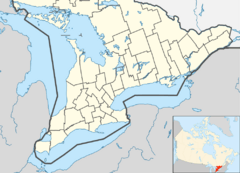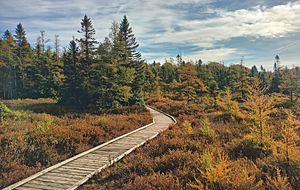Sifton Bog facts for kids
Quick facts for kids Sifton Bog Environmentally Significant Area |
|
|---|---|

Redmond's Pond
|
|
| Location | London, Ontario, Canada |
| Area | 41.6 ha (103 acres) |
| Created | 1967 |
| Governing body | Upper Thames River Conservation Authority |
The Sifton Bog Environmentally Significant Area is a special wetland near London, Ontario, Canada. It's like a big, watery nature park. The city of London and the Upper Thames River Conservation Authority work together to protect it. This bog is considered a very important wetland for the whole province. You can find it west of Hyde Park Road and south of Oxford Street, right inside London's city limits.
Contents
What's in a Name?
Before 1967, this wetland was known as "Byron Bog." It got its current name, Sifton Bog, when the Sifton Construction Company donated the land. But that wasn't its first name!
A History of Names
In the 1880s, people called it Foster's Bog or Redmond's Bog. These names came from the families who owned the land back then. By the 1890s, it was sometimes called Spruce Bog because of the trees growing there. The name Byron Bog became common in the 1920s. Sadly, we don't have any records of what Indigenous peoples called this special place.
A Unique Wetland
The Sifton Bog is one of the most southerly acidic bogs in Canada. This means its water is quite sour, which makes it a unique home for certain plants.
Rare Plants and Carnivores
This bog is home to several rare plant species. Some of the most interesting are its four types of carnivorous plants! These plants "eat" insects to get nutrients they can't find in the bog's soil.
- Two types of sundews: Drosera intermedia and Drosera rotundifolia
- The purple pitcher plant: Sarracenia purpurea
The main plants in the center of the bog are Sphagnum moss and Chamaedaphne calyculata, also known as leatherleaf. You'll also see a few short larches (Larix laricina) and black spruce (Picea mariana) trees.
How the Bog Was Formed
The Sifton Bog sits in a dip in the land. This dip was created long ago by glaciers, which are like giant sheets of ice.
Glacial History
As the glaciers melted and moved away, they left behind a depression in the Ingersoll Glacial Moraine. This created a low spot with no natural way for water to drain out. Over thousands of years, this undrained pocket slowly filled with water and plant material, eventually becoming the Sifton Bog.
Redmond's Pond
At the very center of the bog is Redmond's Pond. It's a small pond, only about 0.2 hectares (half an acre) in size. This pond is what's left of a much larger body of water that was once 23 hectares (about 57 acres). Over the last 10,000 years, peat has slowly filled in most of the original pond. The layer of peat in the middle of the bog is very deep, about 18 meters (60 feet)!
The pond is named after the Redmond family, who owned part of the land from 1854 to 1900. It's not very deep, less than 1.5 meters (5 feet). The water in the pond is also quite acidic, with a pH of around 5. You can find other interesting plants growing around the edges of the pond, like the carnivorous bladderwort (Utricularia vulgaris) and water lily (Nuphar advena). There are also small floating plants like duckweed (Lemna minor) and water flax-seed (Spirodela polyrhiza).
Past Uses of the Bog
The Sifton Bog wasn't always just a nature preserve. People used some of its natural resources in the past.
Wartime Contributions
During the First World War, sphagnum moss from the bog was collected. This moss was used as an alternative to cotton gauze for bandages in hospitals and to support the war effort. Later, during the Second World War, a plant called Alder Buckthorn, which grows naturally in the bog, was harvested. This plant was used to make gunpowder.



